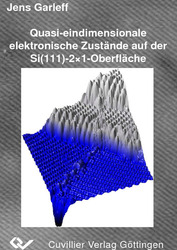| Departments | |
|---|---|
| Book Series (96) |
1366
|
| Nachhaltigkeit |
3
|
| Gesundheitswesen |
1
|
| Humanities |
2355
|
| Natural Sciences |
5398
|
| Mathematics | 229 |
| Informatics | 319 |
| Physics | 979 |
| Chemistry | 1362 |
| Geosciences | 131 |
| Human medicine | 243 |
| Stomatology | 10 |
| Veterinary medicine | 102 |
| Pharmacy | 147 |
| Biology | 835 |
| Biochemistry, molecular biology, gene technology | 121 |
| Biophysics | 25 |
| Domestic and nutritional science | 45 |
| Agricultural science | 1004 |
| Forest science | 201 |
| Horticultural science | 20 |
| Environmental research, ecology and landscape conservation | 148 |
| Engineering |
1785
|
| Common |
97
|
|
Leitlinien Unfallchirurgie
5. Auflage bestellen |
|
Advanced Search
Quasi-eindimensionale elektronische Zustände auf der Si(111)-2x1-Oberfläche (English shop)
Jens Karsten Garleff (Author)Preview
Table of Contents, Datei (40 KB)
Extract, Datei (280 KB)
Die 2×1-rekonstruierte Si(111)-Spaltfläche stellt ein wichtiges Modellsystem der experimentellen und theoretischen Oberflächenphysik dar. In dieser Arbeit wurde sie erstmals bei tiefer Temperatur von 8 K mit Rastertunnelmikroskopie und – spektroskopie untersucht. Die hohe laterale Auflösung des Tunnelmikroskops im sub-Å-Bereich erlaubte es, die elektronische Struktur von Si(111)-2×1 innerhalb der Oberflächeneinheitszelle (6,65×3,84 Å2) vermessen, die sehr gut mit aktuellen theoretischen Rechnungen übereinstimmt. Die im zugrunde liegenden Pandey-Modell erwartete stark anisotrope elektronische Struktur in den π-bonded chains spiegelt sich auch im Kontrast von substitutionellen P-Atomen in der Oberfläche wieder. Er erstreckt sich über viele Nanometer längs einzelner π-bonded chains und bestätigt den 1D-Charakter der Rekonstruktion. Anhand vier verschiedener Typen dieses Kontrasts konnten P-Atome auf den nicht-äquivalenten Gitterplätzen der Rekonstruktion zugeordnet werden. Defekte wie Stufen und P-Atome teilen die π-bonded chains in Segmente endlicher Länge mit einer Kapazität von wenigen aF. Die extrem kleine Kapazität öffnet ein Coulomb-Gap im Tunneltransport durch das Segment, dessen Größe mit der inversen Segmentlänge skaliert. Die in dieser Arbeit vorgestellten Daten passen quantitativ mit der klassisch abgeschätzten Kapazität zusammen und liefern so einen Beweis für ein 1D Elektronensystem auf der Si(111)-2×1-Oberfläche.
The cleaved Si(111) surface exhibits a 2×1 reconstruction and has been subject to extended theoretical and experimental investigation during the last 50 years. Nevertheless, this work presents the first study employing scanning tunneling microscopy and -spectroscopy at low temperature of 8 K. This method provides best lateral resolution and allows to investigate the electronic structure within the surface unit cell of Si(111)-2×1. The presented results nicely agree with most recent ab-initio calculations based on Pandey‘s π-bonded chain model which suggests highly anisotropic surface bands. The contrast of substitutional P atoms extends several nanometer along a single or a double chain and confirms the expected anisotropy. Four different types of this contrast are identified and assigned to P atoms substituted on non-equivalent sites in the reconstructed surface. Furthermore defects like steps or P atoms cut the π-bonded chains to segments of finite length with a capacitance of only a few aF. Due to this extremely small capacitance a Coulomb gap opens in the tunneling transport through the segment. The gap width linearly scales with the inverse length of the segment and quantitatively agrees with a classical approximation based on the segment‘s capacitance. The presented results give first experimental evidence for a 1D electronic system in the Si(111)-2×1 surface.
| ISBN-13 (Printausgabe) | 3865374891 |
| ISBN-13 (Hard Copy) | 9783865374899 |
| ISBN-13 (eBook) | 9783736914896 |
| Language | German |
| Page Number | 148 |
| Edition | 1 |
| Volume | 0 |
| Publication Place | Göttingen |
| Place of Dissertation | Göttingen |
| Publication Date | 2005-07-04 |
| General Categorization | Dissertation |
| Departments |
Physics
|








